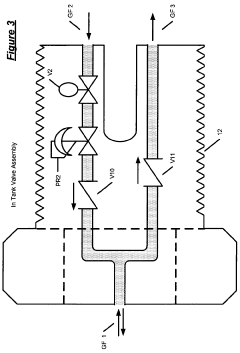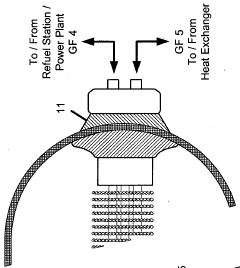Advanced Thermal Management Systems For Check Valves
Technology Background And Goals
This report offers a comprehensive overview of the development history and evolution trends in the field of advanced thermal management systems for check valves. This includes tracing the key milestones and technological breakthroughs that have shaped the progress of this technology over time. Additionally, it aims to clearly define the expected technological goals and performance targets that future advancements in this domain should strive to achieve.
The analysis will shed light on the driving forces behind the need for improved thermal management solutions in check valve applications, such as increasing operational demands, stricter safety regulations, or the pursuit of higher efficiency and reliability. By understanding the historical context and motivations, a solid foundation can be established for exploring potential future directions and innovations in this technological area.
Technology Market Demand Analysis
- Market Size and Growth
Analyze the current and projected market size for advanced thermal management systems in check valves, considering factors like industrial adoption rates, regulatory requirements, and technological advancements. - Industry Trends
Identify key trends shaping the demand for thermal management solutions, such as the need for improved efficiency, reliability, and environmental compliance in various industries using check valves. - Application Areas
Highlight the major application areas driving the demand for advanced thermal management systems in check valves, including power generation, oil and gas, chemical processing, and others. - Regional Dynamics
Assess the regional variations in market demand, considering factors like industrial development, regulatory landscapes, and climatic conditions that influence the need for thermal management solutions. - Customer Segments
Identify the key customer segments, such as original equipment manufacturers (OEMs), end-users, and aftermarket service providers, and analyze their specific requirements and preferences.
Technology Status And Challenges
- Technology Evolution
Tracing the development of thermal management systems for check valves, from traditional air cooling to advanced liquid cooling techniques. - Key Challenges
Identifying critical challenges, such as high heat flux, limited space, and compatibility with harsh environments. - Geographical Distribution
Analyzing the regional concentration of research and development efforts in this field, highlighting leading countries and institutions.
Current Technical Solutions
01 Thermal Management Check Valves
Check valves are used in thermal management systems to control the flow of coolant or refrigerant, allowing flow in one direction while preventing backflow, ensuring efficient heat transfer and preventing system malfunctions. They can be designed for specific temperature ranges and flow rates to optimize thermal management performance.- Check Valves for Thermal Management: Check valves are used in thermal management systems to control the flow of coolant or refrigerant, allowing flow in one direction while preventing backflow, ensuring efficient heat transfer and preventing system damage. They can be designed for specific temperature ranges and flow rates.
- Integrated Thermal Management: Some check valves incorporate thermal management features, such as heat sinks or cooling fins, to dissipate heat generated by valve operation or fluid flow, helping maintain optimal performance and prevent overheating in high-temperature applications.
- Thermal Management for Assemblies: Check valve assemblies, including multiple valves, fittings, and components, can incorporate thermal management systems to regulate the temperature of the entire assembly, using cooling jackets, heat exchangers, or other cooling mechanisms to maintain the desired operating temperature range.
- Temperature-Resistant Materials: To withstand high temperatures, check valves can be constructed using temperature-resistant materials, such as high-temperature alloys, ceramics, or specialized polymers, ensuring structural integrity and preventing deformation or degradation under extreme thermal conditions.
- Actuator Thermal Management: In some applications, check valves may be actuated by mechanisms that generate heat, such as solenoids or motors. Thermal management strategies can be implemented to cool these actuators and prevent overheating, ensuring reliable valve operation and extended component life.
02 Improved Thermal Performance
Certain check valve designs aim to enhance thermal performance by reducing pressure drop, improving flow characteristics, or incorporating materials with high thermal conductivity, leading to more efficient heat transfer and better overall thermal management.Expand Specific Solutions03 High-Temperature Applications
Some check valves are designed specifically for use in high-temperature environments, such as in automotive or industrial applications, incorporating heat-resistant materials, specialized sealing mechanisms, or unique designs to withstand extreme temperatures while maintaining reliable operation.Expand Specific Solutions04 Integrated Thermal Management Systems
In some thermal management systems, check valves are integrated into other components or assemblies, such as heat exchangers, pumps, or cooling modules, simplifying system design, reducing the number of components, and improving overall efficiency and performance.Expand Specific Solutions05 Advanced Materials and Coatings
To enhance thermal performance and durability, check valves can incorporate advanced materials or coatings, such as ceramics, composites, or specialized coatings that improve heat transfer, reduce friction, or provide corrosion resistance in demanding thermal environments.Expand Specific Solutions
Technology Main Player Analysis
Honda Motor Co., Ltd.
BYD Co., Ltd.
Key Technology Interpretation
- Integrating a thermal management system with a valve control system to regulate gas flow and reduce stresses caused by temperature and pressure changes during tank filling and depletion.
- Allowing for low pressure operation in fuel conduit tubes during driving, tank warming during driving, and complete shut off during parking.
- Reducing the effects of relative axial displacement or rotation between the heat exchanger and the tank caused by stress factors associated with temperature and pressure changes.
Check Valve Thermal Management Environmental Impact Analysis
The environmental impact of check valves with advanced thermal management systems can be significant in terms of energy efficiency and emissions reduction in industrial settings. These systems are designed to handle high temperatures and pressures, ensuring that energy losses are minimized through improved thermal regulation. This can lead to a reduction in fuel consumption and lower greenhouse gas emissions, as the systems operate more efficiently compared to traditional valves. By maintaining optimal thermal conditions, the lifespan of the equipment can be extended, which in turn reduces waste and the environmental footprint associated with manufacturing and disposing of outdated components.
Additionally, the use of advanced materials and coatings in these valves can further diminish environmental impact by enhancing durability and resistance to corrosion. This means fewer replacements and less resource consumption over time. The implementation of these systems can also lead to fewer leaks and spills, preventing environmental contamination. In sum, while the initial investment in such advanced technologies may be higher, the long-term environmental benefits and savings in operational costs present a compelling case for their adoption in industries focused on sustainability.



